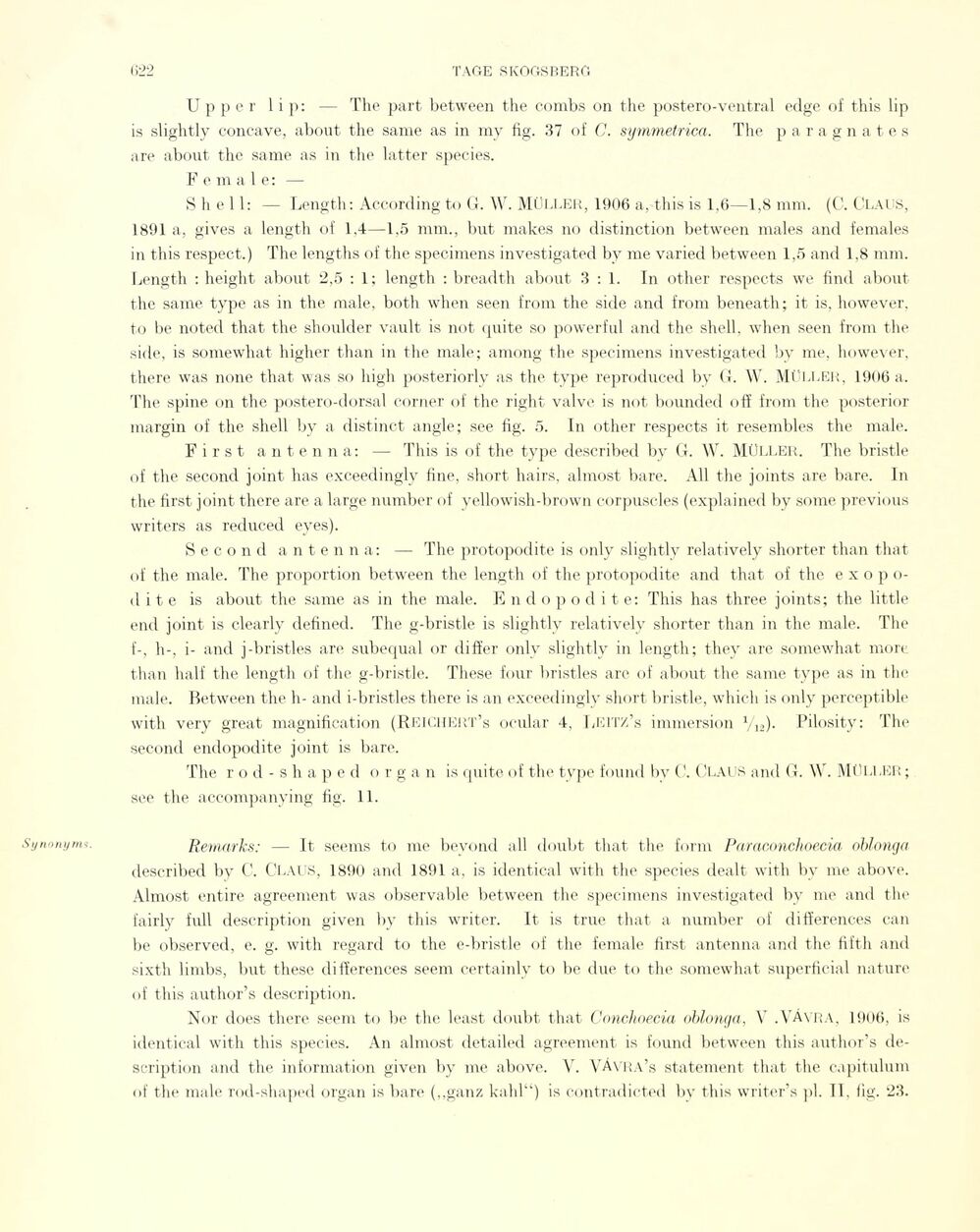
Full resolution (JPEG) - On this page / på denna sida - Sidor ...

<< prev. page << föreg. sida << >> nästa sida >> next page >>
Below is the raw OCR text
from the above scanned image.
Do you see an error? Proofread the page now!
Här nedan syns maskintolkade texten från faksimilbilden ovan.
Ser du något fel? Korrekturläs sidan nu!
This page has never been proofread. / Denna sida har aldrig korrekturlästs.
Synonyms.
Upper 1 i p: — The part between the combs on the postero-ventral edge of this lip
is slightly concave, about the sanie as in my hg. 37 of C. symmetrica. The parag nates
are about the same as in the latter species.
F e m a 1 e : —
Shell: — Length: According to G. W. MÜLLER, 1906 a, this is 1,6—1,8 mm. (C. CLAUS,
1891 a, gives a length of 1,4—1,5 mm., but makes no distinction between males and females
in this respect.) The lengths of the specimens investigated by me varied between 1,5 and 1,8 mm.
Length : height about 2,5 : 1; length : breadth about 3:1. In other respects we find about
the same type as in the male, both when seen from the side and from beneath; it is, however,
to be noted that the shoulder vault is not quite so powerful and the shell, when seen from the
side, is somewhat higher than in the male; among the specimens investigated by me, however,
there was none that was so high posteriorly as the type reproduced by G. W. MÜLLER, 1906 a.
The spine on the postero-dorsal corner of the right valve is not bounded oft’ from the posterior
margin of the shell by a distinct angle; see fig. 5. In other respects it resembles the male.
First antenna: — This is of the type described by G. W. MÜLLER. The bristle
of the second joint has exceedingly fine, short hairs, almost bare. All the joints are bare. In
the first joint there are a large number of yellowish-brown corpuscles (explained by some previous
writers as reduced eyes).
Second antenna: — The protopodite is only slightly relatively shorter than that
of the male. The proportion between the length of the protopodite and that of the e x o p
o-d i t e is about the same as in the male. Endopodite: This has three joints; the little
end joint is clearly defined. The g-bristle is slightly relatively shorter than in the male. The
f-, h-, i- and j-bristles are subequal or differ only slightly in length; they are somewhat more
than half the length of the g-bristle. These four bristles are of about the same type as in the
male. Between the h- and i-bristles there is an exceedingly short bristle, which is only perceptible
with very great magnification (Reichert’s ocular 4, Leitz’s immersion yi2). Pilosity: The
second endopodite joint is bare.
The rod-shaped o r g a n is quite of the type fourni bv C. CLAUS and G. W. MÜLLER ;
see the accompanying fig. 11.
Remarks: — It seems to me beyond all doubt that the forni Paraconchoecia oblonga
described by C. Claus, 1890 and 1891 a, is identical with the species dealt with by me above.
Almost entire agreement was observable between the specimens investigated by me and the
fairly füll description given by this writer. It is true that a number of differences can
be observed, e. g. with regard to the e-bristle of the female first antenna and the fifth and
sixth limbs, but these differences seem certainly to be due to the somewhat superficial nature
of this author’s description.
Nor does there seem to be the least doubt that Conchoecia oblonga, Y .VÂyra, 1906, is
identical with this species. An almost detailed agreement is fourni between this author’s
description and the information given by me above. V. VÀVRA’s statement that the capitulum
of the male rod-shaped organ is bare („ganz kahl“) is contradicted by this writer’s pi. II. fig. 23.
<< prev. page << föreg. sida << >> nästa sida >> next page >>